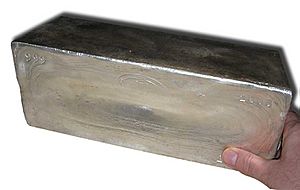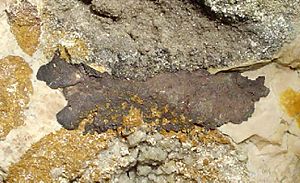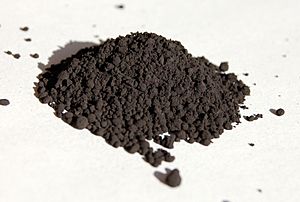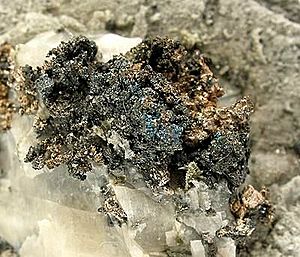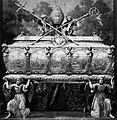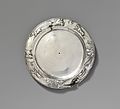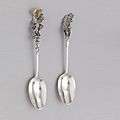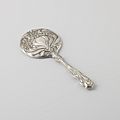Silver facts for kids
Silver (symbol Ag) is a special type of material called a chemical element. In chemistry, silver is element number 47. It is known as a transition metal. Its symbol, Ag, comes from the Latin word argentum, which means silver.
Contents
What is Silver Like?
Physical Features
Silver is a soft and valuable metal. It is known as a precious metal. When silver is used to make money or jewellery, it is often mixed with other metals like gold. This makes it harder and stronger.
Silver has a beautiful bluish-white color. It is very good at reflecting light, which makes it look shiny. It is also an excellent conductor of electricity, meaning electricity can flow through it easily.
Silver is very malleable, which means it can be hammered into thin sheets. It is also very ductile, meaning it can be pulled into long, thin wires. Did you know that "silver" is one of the only words in the English language that doesn't rhyme with any other word? You can buy and sell silver coins and bars in special coin shops around the world.
Chemical Features
Silver is not a very reactive metal. This means it doesn't easily mix with other chemicals. It usually does not dissolve in most acids. However, it will dissolve in Nitric acid to create a substance called silver nitrate.
Silver does not rust easily. It only changes when there is a gas called hydrogen sulfide in the air. When this happens, silver gets a black coating on its surface. This black coating is called tarnish.
Silver can exist in different forms called oxidation states. The most common form is called +1. There are a few rare forms in the +2 oxidation state, but these are very strong chemicals. Silver compounds can be different colors like brown, black, yellow, gray, or even clear. Many silver compounds are good at killing germs.
- Common Silver Compounds (Silver(I))
These silver compounds are more common and can be used to kill germs.
- Silver bromide: a light yellow substance.
- Silver chloride: a white substance.
- Silver iodide: a yellow substance.
- Silver nitrate: a clear substance.
- Silver oxide: a brown-black substance.
- Silver sulfide: a black substance that causes tarnish.
Where is Silver Found?
Silver can be found naturally as a pure metal in the earth. It is also found mixed with other metals like copper, lead, or gold inside rocks. These rocks are mostly found in countries like Canada, Mexico, Peru, and the United States. Peru produces the most silver in the world.
Silver is also found in chemical compounds. For example, a mineral called Acanthite is a type of silver compound that is mined for silver.
How is Silver Made Ready?
Silver is taken out of the earth in different ways. One common method is called electrolysis. This process uses electricity to separate the silver from other materials.
What is Silver Used For?
As a Metal
People have used silver for thousands of years all over the world. It has been used for jewellery, as money, and for many other things. Even though it looks grey, it is often called a "white metal." The word silver is also used to describe this color.
Silver is also used for utensils (like forks and spoons). In dentistry, it can be used to fill teeth as part of a mixture called an amalgam. Silver is also used as a catalyst, which means it helps chemical reactions happen faster.
In Compounds
Silver compounds are good at killing bacteria and have other useful properties. They are used in silver oxide batteries, which are small batteries used in watches and other devices. Silver compounds are also used in photographic film to capture images.
Some silver compounds can help reduce bad smells in clothes. They are also used in special creams that help burns heal faster.
History of Silver
Silver has been important for thousands of years. For a long time, it was considered the second most valuable metal after gold. The ancient Romans used silver as money. The symbol for silver, Ag, comes from its Latin name, argentum. People also used silver in the past to help prevent infections and decay.
Is Silver Safe?
Pure silver is not very dangerous to humans. However, some silver compounds can be harmful. They can make the skin turn blue, and some might even cause serious health problems. A common homeopathic remedy called colloidal silver is generally not harmful in small amounts, but it also doesn't have many proven benefits.
Silver in the Market
Because silver is being used up quickly, some people believe it might become even more valuable than gold in the future. More silver has been used each year than has been mined since 1990. This means the world's supply of stored silver is getting smaller.
Some companies that use silver have benefited from people called speculators. These speculators sell promises to deliver silver that doesn't actually exist, which can keep prices artificially low. This is called naked short selling. The amount of silver that is "owed" is more than all the silver that exists in the world. The price of silver could go very high if the stored silver runs out and investors start asking for their actual metal instead of just promises.
In June 2010, silver was about 18 US dollars per troy ounce. By December 2010, it had increased to 28 US dollars per troy ounce.
| Periodic table | |||||||||||||||||||||||||||||||||||||||||
|---|---|---|---|---|---|---|---|---|---|---|---|---|---|---|---|---|---|---|---|---|---|---|---|---|---|---|---|---|---|---|---|---|---|---|---|---|---|---|---|---|---|
| H | He | ||||||||||||||||||||||||||||||||||||||||
| Li | Be | B | C | N | O | F | Ne | ||||||||||||||||||||||||||||||||||
| Na | Mg | Al | Si | P | S | Cl | Ar | ||||||||||||||||||||||||||||||||||
| K | Ca | Sc | Ti | V | Cr | Mn | Fe | Co | Ni | Cu | Zn | Ga | Ge | As | Se | Br | Kr | ||||||||||||||||||||||||
| Rb | Sr | Y | Zr | Nb | Mo | Tc | Ru | Rh | Pd | Ag | Cd | In | Sn | Sb | Te | I | Xe | ||||||||||||||||||||||||
| Cs | Ba | La | Ce | Pr | Nd | Pm | Sm | Eu | Gd | Tb | Dy | Ho | Er | Tm | Yb | Lu | Hf | Ta | W | Re | Os | Ir | Pt | Au | Hg | Tl | Pb | Bi | Po | At | Rn | ||||||||||
| Fr | Ra | Ac | Th | Pa | U | Np | Pu | Am | Cm | Bk | Cf | Es | Fm | Md | No | Lr | Rf | Db | Sg | Bh | Hs | Mt | Ds | Rg | Cn | Uut | Fl | Uup | Lv | Uus | Uuo | ||||||||||
|
|||||||||||||||||||||||||||||||||||||||||
Images for kids
-
The three common silver halide precipitates: from left to right, silver iodide, silver bromide, and silver chloride.
-
Silver mining and processing in Kutná Hora, Bohemia, 1490s
-
Acanthite sample from the Imider mine in Morocco
-
Embossed silver sarcophagus of Saint Stanislaus in the Wawel Cathedral was created in main centers of the 17th century European silversmithery - Augsburg and Gdańsk
-
A tray of South Asian sweets, with some pieces covered with shiny silver vark
-
Proto-Elamite kneeling bull holding a spouted vessel; 3100–2900 BC; 16.3 x 6.3 x 10.8 cm; Metropolitan Museum of Art (New York City)
-
Ancient Egyptian figurine of Horus as falcon god with an Egyptian crown; circa 500 BC; silver and electrum; height: 26.9 cm; Staatliche Sammlung für Ägyptische Kunst (Munich, Germany)
-
Ancient Greek tetradrachm; 315–308 BC; diameter: 2.7 cm; Metropolitan Museum of Art
-
Roman plate; 1st–2nd century AD; height: 0.1 cm, diameter: 12.7 cm; Metropolitan Museum of Art
-
Auricular basin with scenes from the story of Diana and Actaeon; 1613; length: 50 cm, height: 6 cm, width: 40 cm; Rijksmuseum (Amsterdam, the Netherlands)
-
French Rococo tureen; 1749; height: 26.3 cm, width: 39 cm, depth: 24 cm; Metropolitan Museum of Art
-
French Neoclassical ewer; 1784–1785; height: 32.9 cm; Metropolitan Museum of Art
-
Neo-Rococo coffeepot; 1845; overall: 32 x 23.8 x 15.4 cm; Cleveland Museum of Art (Cleveland, Ohio, USA)
-
French Art Nouveau dessert spoons; circa 1890; Cooper Hewitt, Smithsonian Design Museum (New York City)
-
Hand mirror; 1906; height: 20.7 cm, weight: 88 g; Rijksmuseum (Amsterdam, the Netherlands)
-
Mystery watch; ca. 1889; diameter: 5.4 cm, depth: 1.8 cm; Musée d'Horlogerie of Le Locle, (Switzerland)
See also
 In Spanish: Plata para niños
In Spanish: Plata para niños


